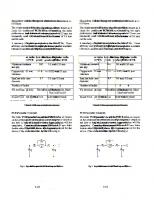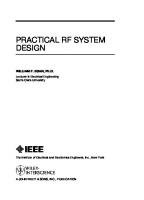Practical RF circuit design for modern wireless systems [Volume 2] 9781580535229, 1-58053-522-4, 1580535216
Reference covers active and nonlinear circuits, and introduces advanced topics in RF circuit and system design. For RF d
392 68 50KB
English Pages 588 Year 2003
Table of contents :
Practical RF Circuit Design for
Modern Wireless Systems......Page 4
Copyright......Page 5
Contents......Page 8
Preface......Page 14
Acknowledgments......Page 18
1.1 Introduction......Page 20
1.2 Power gain definitions......Page 22
1.3 Neutralization......Page 26
1.4 Unilateral transducer gain......Page 27
1.4.1 Unilateral figure of merit......Page 29
1.4.2 Illustrative example: unilateral gain calculations......Page 31
1.4.3 Amplifier design with single matching networks......Page 32
1.4.5 Illustrative example: single- sided amplifier design......Page 34
1.5 RF circuit stability considerations......Page 38
1.5.1 What may cause RF oscillation......Page 41
1.5.2 Stability analysis with arbitrary source and load terminations......Page 44
1.5.3 Two- port stability considerations......Page 49
1.5.4 Stability circles......Page 54
1.5.5 Graphical forms of unconditional stability......Page 59
1.5.6 Graphical forms of potential instability......Page 60
1.5.7 Caution about multistage systems......Page 61
1.6 Stabilizing an active two- port......Page 65
1.6.1 Finding the minimum- loss resistor at the input of the device......Page 66
1.6.2 Broadband stability considerations......Page 68
1.7.1 Examining the effect of lossless feedback......Page 69
1.7.2 Device stabilization......Page 70
1.8 The dc bias techniques......Page 78
1.8.1 Passive dc bias networks......Page 79
1.8.2 Active dc bias circuits......Page 82
1.8.3 Feeding dc bias into the RF circuit......Page 83
1.8.4 The dc bias circuit simulation......Page 84
1.9 Statistical and worst- case analyses......Page 88
1.10 Circuit layout considerations......Page 90
1.12 Problems......Page 93
2.1 Introduction......Page 96
2.2 Bilateral RF amplifier design for maximum small- signal gain......Page 97
2.2.1 Illustrative exercise: amplifier design for maximum gain, G......Page 101
2.3.1 Cascading impedance- matched stages......Page 107
2.3.2 Cascading amplifiers by direct impedance matching......Page 108
2.3.3 Output power and impedance match considerations of cascaded amplifiers......Page 111
2.4 Operating gain design for maximum linear output power......Page 113
2.4.1 Operating gain design outline......Page 114
2.4.3 Stability considerations......Page 116
2.4.4 Illustrative example: operating gain design for maximum linear power output......Page 117
2.4.5 Output match considerations......Page 120
2.5.1 Review of noise sources in RF systems......Page 121
2.5.2 Two- port noise parameter definitions......Page 125
2.6 Available gain design technique......Page 126
2.6.1 Available gain design outline......Page 127
2.6.2 Low- noise amplifier design considerations......Page 129
2.6.3 Illustrative example: design of a single- ended 1.9- GHz LNA......Page 130
2.6.4 Balanced amplifiers......Page 133
2.6.5 Illustrative example: design of a balanced LNA for the 1.7- to 2.3- GHz frequency range......Page 135
2.7 Comparison of the various amplifier designs and Smith chart ¨C based graphical design aids......Page 140
2.8 Broadband amplifiers......Page 142
2.8.1 Reactive match/ mismatch approach......Page 143
2.8.2 Dissipative mismatch at input and/ or output ports......Page 144
2.8.4 Feedback amplifiers......Page 148
2.8.5 Distributed amplifiers......Page 160
2.9 Summary......Page 161
2.10 Problems......Page 162
3 Active RF devices and their modeling......Page 166
3.1 The diode model......Page 167
3.2 Two- port device models......Page 169
3.2.2 The bipolar transistor......Page 172
3.2.3 The heterojunction bipolar transistor......Page 192
3.2.4 The GaAs MESFET......Page 196
3.2.5 The high- electron mobility transistor......Page 203
3.2.6 Silicon LDMOS and CMOS technologies......Page 206
3.3 Problems......Page 209
4.1 Classification of nonlinear circuit simulators......Page 212
4.1.2 Time- domain methods......Page 213
4.1.3 Hybrid time- and frequency- domain techniques ¡ª harmonic balance......Page 216
4.1.4 Frequency- domain techniques......Page 219
4.2 The harmonic balance method......Page 221
4.3 Harmonic balance analysis of oscillators......Page 226
4.3.1 Oscillator analysis using probes......Page 227
4.3.2 Oscillator analysis using reflection coefficients of the device and resonant load......Page 228
4.3.3 Oscillator analysis using a directional coupler to measure open- loop gain......Page 233
5.1 Nonlinear concepts......Page 236
5.1.1 Some nonlinear phenomena......Page 239
5.2 Quasi- linear power amplifier design......Page 242
5.2.1 The amplifier load line......Page 243
5.2.2 Load pull methods......Page 251
5.3.1 Class- A amplifier......Page 262
5.3.2 Class- B amplifier......Page 267
5.3.3 Class- F amplifier......Page 276
5.3.4 Comparison of class- A, class- B, class- F, and other operational modes......Page 284
5.3.5 Switching- mode amplifiers......Page 290
5.3.6 Cascaded power amplifier design......Page 297
5.4 Power amplifier design example......Page 299
5.4.1 Transistor selection......Page 300
5.4.2 Transistor characterization......Page 301
5.4.3 Matching the input and output of the device......Page 305
5.4.4 Harmonic tuning example......Page 315
5.5.1 Bias changes at the input......Page 317
5.5.2 Bias changes at the output......Page 321
5.5.3 Bias considerations with power devices......Page 323
5.6 Distortion reduction......Page 326
5.6.1 The importance of amplifier linearity......Page 328
5.6.2 Operating the amplifier backed off......Page 330
5.6.3 Predistortion......Page 331
5.6.4 Feedforward cancellation......Page 336
5.6.5 Device modification......Page 338
5.6.6 System- level reduction of distortion......Page 344
5.7 Problems......Page 347
6 Oscillators......Page 356
6.1.1 Two- port oscillator design approach......Page 357
6.1.2 One- port oscillator design approach......Page 368
6.1.3 Transistor oscillator configurations......Page 392
6.1.4 Characterizing oscillator phase noise......Page 409
6.2.1 45.455- MHz Colpitts crystal oscillator design......Page 423
6.2.2 Design of a 3.7- to 4.2- GHz voltage- controlled oscillator......Page 429
6.3 Problems......Page 448
7.1 Mixer overview and their applications in systems......Page 452
7.2 Diode mixers and their topologies......Page 461
7.2.1 Single- ended mixer......Page 462
7.2.2 Single- balanced mixer......Page 464
7.2.3 Double- balanced mixer......Page 470
7.2.4 The image problem in mixers......Page 474
7.2.5 Harmonic components in mixers......Page 479
7.3.1 Active transistor mixers......Page 483
7.3.2 Resistive FET mixers......Page 507
7.3.3 Dual- gate FET mixers......Page 513
7.3.4 Comparison of mixers......Page 519
7.4 Frequency multipliers ¡ª an overview......Page 520
7.4.1 Frequency doublers......Page 521
7.4.2 Arbitrary frequency multiplication......Page 524
7.5 Problems......Page 525
8.1 Mobile telephony systems......Page 528
8.1.1 Second generation mobile systems......Page 529
8.1.2 Third generation mobile systems......Page 531
8.2.1 RF digital processing......Page 534
8.2.2 Digital processing of a wideband IF......Page 536
8.2.3 Digital processing at baseband ( direct conversion)......Page 537
8.2.4 Transceiver issues associated with software- defined radio......Page 539
8.3.1 The air interface specification for PHS......Page 541
8.3.2 Component specification......Page 542
8.3.3 Component design......Page 544
8.4 Integrated system chips: an overview......Page 550
8.4.1 RF receiver front ends......Page 551
8.4.2 RF upconverters and transmitter driver amplifiers......Page 555
8.4.3 Transceiver and complete radio solutions......Page 557
8.4.4 Power amplifier modules......Page 562
8.5 Conclusion......Page 563
Summary of Basic Formulas ¨C 1......Page 566
Summary of Basic Formulas ¨C 2......Page 568
About the Authors......Page 570
Index......Page 572
Practical RF Circuit Design for
Modern Wireless Systems......Page 4
Copyright......Page 5
Contents......Page 8
Preface......Page 14
Acknowledgments......Page 18
1.1 Introduction......Page 20
1.2 Power gain definitions......Page 22
1.3 Neutralization......Page 26
1.4 Unilateral transducer gain......Page 27
1.4.1 Unilateral figure of merit......Page 29
1.4.2 Illustrative example: unilateral gain calculations......Page 31
1.4.3 Amplifier design with single matching networks......Page 32
1.4.5 Illustrative example: single- sided amplifier design......Page 34
1.5 RF circuit stability considerations......Page 38
1.5.1 What may cause RF oscillation......Page 41
1.5.2 Stability analysis with arbitrary source and load terminations......Page 44
1.5.3 Two- port stability considerations......Page 49
1.5.4 Stability circles......Page 54
1.5.5 Graphical forms of unconditional stability......Page 59
1.5.6 Graphical forms of potential instability......Page 60
1.5.7 Caution about multistage systems......Page 61
1.6 Stabilizing an active two- port......Page 65
1.6.1 Finding the minimum- loss resistor at the input of the device......Page 66
1.6.2 Broadband stability considerations......Page 68
1.7.1 Examining the effect of lossless feedback......Page 69
1.7.2 Device stabilization......Page 70
1.8 The dc bias techniques......Page 78
1.8.1 Passive dc bias networks......Page 79
1.8.2 Active dc bias circuits......Page 82
1.8.3 Feeding dc bias into the RF circuit......Page 83
1.8.4 The dc bias circuit simulation......Page 84
1.9 Statistical and worst- case analyses......Page 88
1.10 Circuit layout considerations......Page 90
1.12 Problems......Page 93
2.1 Introduction......Page 96
2.2 Bilateral RF amplifier design for maximum small- signal gain......Page 97
2.2.1 Illustrative exercise: amplifier design for maximum gain, G......Page 101
2.3.1 Cascading impedance- matched stages......Page 107
2.3.2 Cascading amplifiers by direct impedance matching......Page 108
2.3.3 Output power and impedance match considerations of cascaded amplifiers......Page 111
2.4 Operating gain design for maximum linear output power......Page 113
2.4.1 Operating gain design outline......Page 114
2.4.3 Stability considerations......Page 116
2.4.4 Illustrative example: operating gain design for maximum linear power output......Page 117
2.4.5 Output match considerations......Page 120
2.5.1 Review of noise sources in RF systems......Page 121
2.5.2 Two- port noise parameter definitions......Page 125
2.6 Available gain design technique......Page 126
2.6.1 Available gain design outline......Page 127
2.6.2 Low- noise amplifier design considerations......Page 129
2.6.3 Illustrative example: design of a single- ended 1.9- GHz LNA......Page 130
2.6.4 Balanced amplifiers......Page 133
2.6.5 Illustrative example: design of a balanced LNA for the 1.7- to 2.3- GHz frequency range......Page 135
2.7 Comparison of the various amplifier designs and Smith chart ¨C based graphical design aids......Page 140
2.8 Broadband amplifiers......Page 142
2.8.1 Reactive match/ mismatch approach......Page 143
2.8.2 Dissipative mismatch at input and/ or output ports......Page 144
2.8.4 Feedback amplifiers......Page 148
2.8.5 Distributed amplifiers......Page 160
2.9 Summary......Page 161
2.10 Problems......Page 162
3 Active RF devices and their modeling......Page 166
3.1 The diode model......Page 167
3.2 Two- port device models......Page 169
3.2.2 The bipolar transistor......Page 172
3.2.3 The heterojunction bipolar transistor......Page 192
3.2.4 The GaAs MESFET......Page 196
3.2.5 The high- electron mobility transistor......Page 203
3.2.6 Silicon LDMOS and CMOS technologies......Page 206
3.3 Problems......Page 209
4.1 Classification of nonlinear circuit simulators......Page 212
4.1.2 Time- domain methods......Page 213
4.1.3 Hybrid time- and frequency- domain techniques ¡ª harmonic balance......Page 216
4.1.4 Frequency- domain techniques......Page 219
4.2 The harmonic balance method......Page 221
4.3 Harmonic balance analysis of oscillators......Page 226
4.3.1 Oscillator analysis using probes......Page 227
4.3.2 Oscillator analysis using reflection coefficients of the device and resonant load......Page 228
4.3.3 Oscillator analysis using a directional coupler to measure open- loop gain......Page 233
5.1 Nonlinear concepts......Page 236
5.1.1 Some nonlinear phenomena......Page 239
5.2 Quasi- linear power amplifier design......Page 242
5.2.1 The amplifier load line......Page 243
5.2.2 Load pull methods......Page 251
5.3.1 Class- A amplifier......Page 262
5.3.2 Class- B amplifier......Page 267
5.3.3 Class- F amplifier......Page 276
5.3.4 Comparison of class- A, class- B, class- F, and other operational modes......Page 284
5.3.5 Switching- mode amplifiers......Page 290
5.3.6 Cascaded power amplifier design......Page 297
5.4 Power amplifier design example......Page 299
5.4.1 Transistor selection......Page 300
5.4.2 Transistor characterization......Page 301
5.4.3 Matching the input and output of the device......Page 305
5.4.4 Harmonic tuning example......Page 315
5.5.1 Bias changes at the input......Page 317
5.5.2 Bias changes at the output......Page 321
5.5.3 Bias considerations with power devices......Page 323
5.6 Distortion reduction......Page 326
5.6.1 The importance of amplifier linearity......Page 328
5.6.2 Operating the amplifier backed off......Page 330
5.6.3 Predistortion......Page 331
5.6.4 Feedforward cancellation......Page 336
5.6.5 Device modification......Page 338
5.6.6 System- level reduction of distortion......Page 344
5.7 Problems......Page 347
6 Oscillators......Page 356
6.1.1 Two- port oscillator design approach......Page 357
6.1.2 One- port oscillator design approach......Page 368
6.1.3 Transistor oscillator configurations......Page 392
6.1.4 Characterizing oscillator phase noise......Page 409
6.2.1 45.455- MHz Colpitts crystal oscillator design......Page 423
6.2.2 Design of a 3.7- to 4.2- GHz voltage- controlled oscillator......Page 429
6.3 Problems......Page 448
7.1 Mixer overview and their applications in systems......Page 452
7.2 Diode mixers and their topologies......Page 461
7.2.1 Single- ended mixer......Page 462
7.2.2 Single- balanced mixer......Page 464
7.2.3 Double- balanced mixer......Page 470
7.2.4 The image problem in mixers......Page 474
7.2.5 Harmonic components in mixers......Page 479
7.3.1 Active transistor mixers......Page 483
7.3.2 Resistive FET mixers......Page 507
7.3.3 Dual- gate FET mixers......Page 513
7.3.4 Comparison of mixers......Page 519
7.4 Frequency multipliers ¡ª an overview......Page 520
7.4.1 Frequency doublers......Page 521
7.4.2 Arbitrary frequency multiplication......Page 524
7.5 Problems......Page 525
8.1 Mobile telephony systems......Page 528
8.1.1 Second generation mobile systems......Page 529
8.1.2 Third generation mobile systems......Page 531
8.2.1 RF digital processing......Page 534
8.2.2 Digital processing of a wideband IF......Page 536
8.2.3 Digital processing at baseband ( direct conversion)......Page 537
8.2.4 Transceiver issues associated with software- defined radio......Page 539
8.3.1 The air interface specification for PHS......Page 541
8.3.2 Component specification......Page 542
8.3.3 Component design......Page 544
8.4 Integrated system chips: an overview......Page 550
8.4.1 RF receiver front ends......Page 551
8.4.2 RF upconverters and transmitter driver amplifiers......Page 555
8.4.3 Transceiver and complete radio solutions......Page 557
8.4.4 Power amplifier modules......Page 562
8.5 Conclusion......Page 563
Summary of Basic Formulas ¨C 1......Page 566
Summary of Basic Formulas ¨C 2......Page 568
About the Authors......Page 570
Index......Page 572
![Practical RF circuit design for modern wireless systems [Volume 2]
9781580535229, 1-58053-522-4, 1580535216](https://ebin.pub/img/200x200/practical-rf-circuit-design-for-modern-wireless-systems-volume-2-9781580535229-1-58053-522-4-1580535216.jpg)
![Practical RF circuit design for modern wireless systems, Active circuits and systems [vol.II]
1580535224, 9781580535229](https://ebin.pub/img/200x200/practical-rf-circuit-design-for-modern-wireless-systems-active-circuits-and-systems-volii-1580535224-9781580535229.jpg)

![RF MEMS circuit design for wireless communications [1st ed.]
9781580533294, 1-58053-329-9](https://ebin.pub/img/200x200/rf-mems-circuit-design-for-wireless-communications-1stnbsped-9781580533294-1-58053-329-9.jpg)
![RF/microwave circuit design for wireless applications [1 ed.]
0471298182, 9780471298182, 9780471224136, 0471224138](https://ebin.pub/img/200x200/rf-microwave-circuit-design-for-wireless-applications-1nbsped-0471298182-9780471298182-9780471224136-0471224138.jpg)
![RF MEMS Circuit Design for Wireless Communications [1st ed.]
1580533299, 9781580533294, 9781580535571](https://ebin.pub/img/200x200/rf-mems-circuit-design-for-wireless-communications-1stnbsped-1580533299-9781580533294-9781580535571.jpg)


![Circuit design for RF transceivers [1st Edition.]
9781441949202, 1441949208](https://ebin.pub/img/200x200/circuit-design-for-rf-transceivers-1st-edition-9781441949202-1441949208.jpg)

